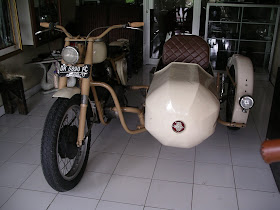
Happy days! I have now have three of my four bikes on the road. In April I took the Ariel over the pits, but as I reported back then it didn't go well. The first thing I did after that debacle was to order a Pazon ignition system from New Zealand (link http://www.pazon.com/) and some replacement pistons and rings. When we got into the engine however, the current pistons, rings and barrels, proved to be in great condition so we didn't replace them. The Pazon system immediately improved performance and made for reliable starting.
I decided that I would go with a concessional license and booked an inspection through the Vintage Motorcycle Club. It was a bit of a nerve wracking exercise because it was quite a ride out to the club in Forrestfield and I'd had almost no practice riding her on the road. I took it really slow, which certainly p*ssed off some drivers. My greatest concern was braking. The front brake is almost useless, barely able to slow the bike, but when used in combination with the footbrake it works okay. But only just okay.
The engine ran well but the gear change was sloppy, crunching in first and second, but third and fourth felt soft and it was often hard to tell which gear I was in. It will take a bit of practice to get the changes right. That all said, the Leader is a smooth ride. Its low centre of gravity makes it feel very stable on the road. It also corners well, although I didn't take any at speed.

The inspection was relatively quick and painless. I was a little more confident on the ride home and pushed her up to 50 miles per hour. Pleasingly she didn't lose speed running up the hill near my house, unlike the Troll and Vespa, which always struggle. Now I'm just waiting on the registration process. I'm crossing my fingers there aren't any more 'bureaucratic' challenges!
Update - 3 August 2010. My paperwork from the Department if Infrastructure and Transport stating, as we already knew, that there is no record of the Ariel being imported since the introduction of import restrictions in 1989. So, here we go. Let's hope this is the last hurdle.
The Troll

And the Troll is now back after six months off the road. The last time I'd ridden the Troll was before New Years Day, when she broke down. Because the kick starter had jammed and would not budge I suspected the piston had seized. Fortunately that proved not to be the case. Both the clutch arm and kick starter had come out of alignment and it only took a bit of pushing and pulling to set them right. A few fixing bolts and washers should keep them together. The leaking petrol tap was replaced, the carburetter cleaned and the old IWL air filter was disconnected and replaced by a new modern one (below). The transformation in performance has been incredible. She fires up on the first or second kick every time now. Amazing!

And finally.. FINALLY.. I was able to secure an IWL badge for the headstock. It's a trivial thing really and a bit battered up, but it these things are very hard to find. So now she is complete.

So it looks like I'm going to have lots of riding choices this summer to do things like this..

And this...










































